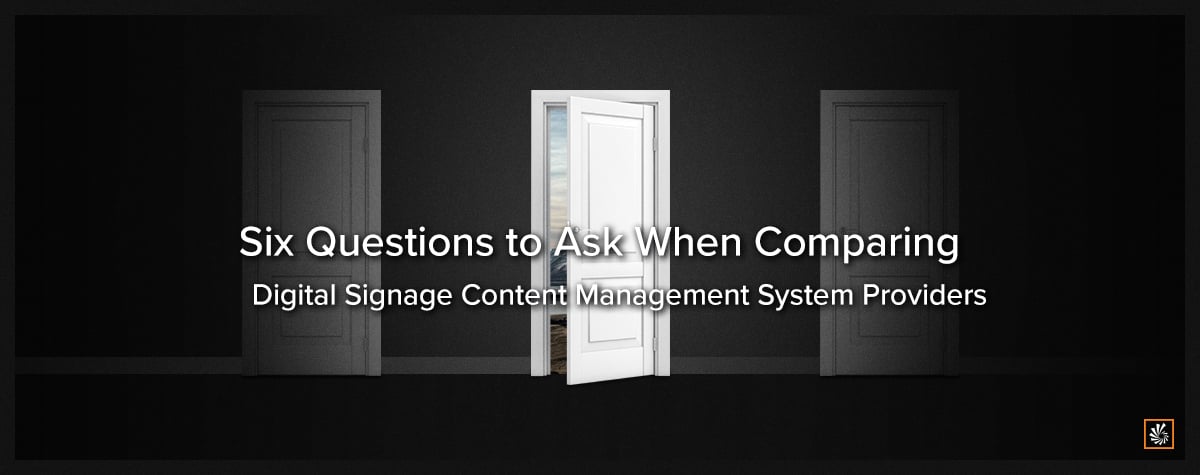All Together Now: Content is Key to the Success of My Digital Signage Investment
Today we come to the end of this series on the importance of digital signage content creation to the success of a successful digital signage strategy. We’ve covered a lot of ground in the last few weeks, so it’s worth a refresher and a recap of the key points.
#1: It’s not about the tech, it’s about digital signage content creation and management
As cool and exciting as the latest and greatest digital signage screens, software, media players and peripherals are, they won’t make a difference in your bottom line, employee engagement, or customer loyalty unless you deliver engaging content experiences. Content should be front-and-center in your digital signage network planning, not the technology and hardware you use to display it.
#2: Recognize the true uniqueness of digital signage as a medium to guide your strategy
Digital signage isn’t just another way of showing broadcast TV commercials or internal videos, nor it is a glorified computer monitor. Yes, you can use digital signage screens to share pre-existing assets (both for broadcast and online), but to what end? Digital signage allows you to combine, mix-and-match, and customize the best aspects of broadcast video, online experiences, social media and more. And because each device is uniquely addressable, you can run specific content to specific screens scattered across a store, across a region, or the entire country. That means you can create strategic, personalized experiences that are both engaging and interactive—and aimed squarely at the different audiences you want to address.
#3: A digital signage content strategy lets you meet your audience and your business goals
Lack of clearly defined business objectives for a digital signage initiative—then failing to build a strategy for reaching those objectives—is the key reason many digital signage initiatives are never deployed or are quickly abandoned. Whether you want to increase sales, improve profitability, reduce employee turnover, enhance customer satisfaction—whatever it is—you have to define the goal before laying down a comprehensive strategy to get there. This includes stating the purpose, intent, and audience for each device/location. Only then can you define a content strategy to fulfill the purpose of those individual devices.
#4: New digital signage content types let you tailor the experience to each venue
Among the biggest misconceptions about digital signage content is the view that simply reusing existing video or online content as is will capture the audiences’ attention. While digital signage can be used for entertainment and informational purposes, in many venues it is a “glance media”—meaning you have mere seconds to capture and hold viewers’ attention.
You will almost certainly have to adjust or augment traditional video content or replace it with motion graphics to convey the message more quickly and concisely. Dynamic, data-driven content lets you create unique, in-the-moment experiences based on any available data. Interactive content apps—while not appropriate for every screen, location, or application—allow you take advantage of input devices like touchscreens, cameras, voice inputs, and more to provide even more engaging experiences. Our Reflect Spark Framework allows you to easily create, deploy, and manage data-driven and interactive content applications as easily as any other content type.
#5: A digital signage content program is for the long haul, so plan on it
Once you deploy your digital signage network and engaging content, how do you keep the momentum going? A content program is not a once-and-done project, but a long-term commitment, which means you have to continue budgeting resources for content creation and optimization. How often you refresh and update your digital signage content depends on many factors, not least the purpose of each device, the audience intent and frequency of visits, and much more. In addition, don’t discount the value of locally created content to augment your centralized programming. With applications like Reflect Xperience, local users can not only ease the content creation burden, they can make your content more relevant for local audiences.
Regardless, you’ll need to apply some basic best practices and monitor the appropriate metrics regularly to optimize the performance of your content and network.
We hope you’ve found this series helpful in planning your digital signage strategy. Unlike this series, your commitment to your content program—as to your overall strategy—is an ongoing, long-term affair. We’d like to make that journey easier. To learn more about Reflect Systems and its our ReflectView digital signage content management platform, connect with us on LinkedIn and Twitter. Better yet, contact us to find out how we can help ensure you get the best long-term ROI from your digital signage network and your content.
Share this
You May Also Like
These Related Stories

Reflect Spark Framework for Managing Dynamic, Data-Driven Digital Signage Content Applications

6 Questions to Ask When Comparing Digital Signage Content Management System Providers


